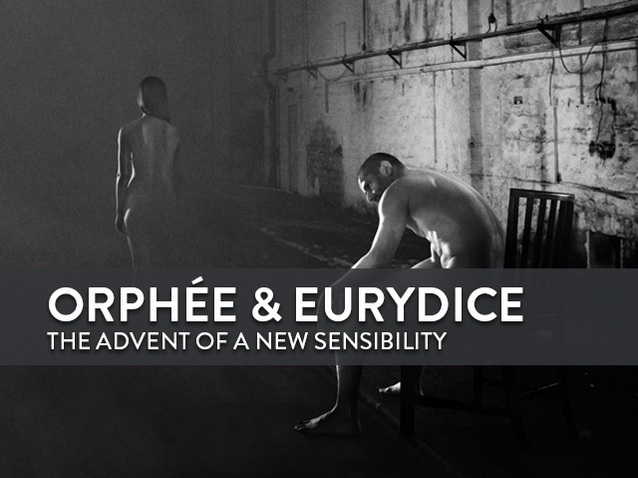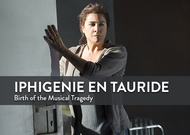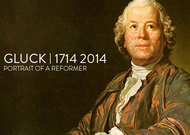 © DR
© DR
Created during the Age of Enlightenment, first in Vienna and later in Paris in a modified version in 1774, Gluck’s Orphée et Eurydice marks the renewal of opera, leaving behind the codes of opera seria in favour of a more streamlined lyric format, with more room for emotion and the expression of a new sensibility.
And Orphée et Eurydice is the work chosen by London’s Royal Opera House to open its 2015-2016 season, with a new production by Hofesh Shechter and John Fulljames, featuring Juan Diego Florez. We are taking this opportunity to analyse the work and its context in the history of opera.
***
“Music will no longer be limited to the beauties of convention at which composers were obliged to halt” wrote Gluck in his dedication of the French score of Orphée et Eurydiceaddressed to Queen Marie-Antoinette.Gluck composed Orfeo ed Euridice, which was staged in 1762 at Vienna’s Burg-Theater, with the intention of ridding opera of its excesses in order to get closer to the truth. This first version, composed to an Italian libretto by Raniero Calzabigi, had greatly impressed the aristocratic audience gathered for a party given in honour of Empress Maria Theresa’s husband. The 1762 Orfeo applied the principles of Gluck’s new concept for lyric drama which he laid out in the dedication of Alceste (1769). When the composer went to Paris in late 1773 to present his Iphigénie en Aulide, he had in his suitcase the score to Orfeo which we proceeded to adapt to the tastes of Parisian audiences by conforming to the customs of French opera. On 2 August 1774, Orphée et Eurydice, a new version rewritten in French, more developed, was presented on the stage of the Palais-Royal, but it still represented a profound revival of lyric dramaturgy by meeting the aspirations of the late 18th century. Many enthusiastic reviews attest to the work’s success; it overwhelmed and exalted “sensitive souls” captivated by the depiction of passion, a source of cruel heartbreak and extreme joy, as in Jean-Jacques Rousseau’s Nouvelle Héloïse (1761).
From Orfeo to Orphée et Eurydice, the wanderings of a metamorphosis
Although operas are often rewritten and transformed in order to meet the necessities of interpretation and performance, few have undergone as many reworkings as Gluck’s Orphée. Without getting into the thorny details of music history, it can be said that there are basically three different versions of this work. The first version was given in Vienna on 5 October 1762. Orfeo ed Euridice, the composer’s thirtieth opera, was part of an already rich lyric career. After brilliantly exploring and exploiting the rules of “opera seria”, which is constructed around a focus on virtuosity, Gluck looked for a way to free himself from the tyranny of musical hedonism. The real turning point in his career came with a decisive meeting, with an Italian scholar attracted to the new aesthetic concepts advanced by Diderot and Rousseau: librettist Raniero di Calzabigi (1714-1795) whose ambition was to revive opera. With the help of this brilliant theoretician, Gluck set off on an ambitious reform of lyrical drama.
Orfeo et Euridice, for which Calzabigi wrote the libretto, was the first attempt to implement the “opera reform” that Gluck wanted: “My purpose was to strip music of the abuses which, introduced by the poorly understood vanity of the singers or by an exaggerated complacency on the part of the masters, have long marred Italian opera…. I intended to restrict music to its true office, which is to serve poetry for the uninterrupted expression of the action, and without damping it down with superfluous ornamentation.” This new requirement, which calls into question the supremacy of the virtuosity dear to bel canto, seeks to promote a stylised musical expression that incorporates the natural inflexions of the spoken language. Singing, as an expression of characters’ innermost feelings, must respect the need to develop a tight plot. That is precisely what characterises Orfeo ed Euridice, which lasts barely an hour and a half.Based on an extremely simple plot, the work harks back to the origins of the genre, marked by the famous myth of Orpheus, which had inspired the subject of the Euridice by Jacopo Peri, considered the first known opera. The famous bard of Thrace, charming men and animals with his divine voice and even moving stones, was for a long time one of the defining characters of the lyric art.
The plot in Calzabigi’s libretto consists of Orpheus’s descent into Hell and his failure in his efforts to bring his wife Eurydice back to the world of the living. Only the intervention of Love, which stops Orpheus’s hand as he draws his sword to kill himself, allows a happy ending consistent with the spirit of the Enlightenment. This favourable outcome points to a permanent faith in man’s capacity to triumph over Fate through courage and virtue. The couple have defeated Death and are once again together despite a momentary setback. In this first Italian version from 1762, the character of Orpheus had an alto voice, that of the role’s creator, castrato Gaetano Guadagni. He continued to improvise spectacular ornamentations to show off his note-holding powers. He could not bring himself to set aside those famous “suitcase” arias, so called because singers carried them in their luggage to use during opera performances, whenever they wanted, with no concern for connecting them to the plot.All these “opera seria” excesses began to clash with the tastes of an evolving audience in the second half of the 18th century.
In 1769, when Orfeo ed Euridice was presented in Parma, Gluck transposed the role of Orpheus for the soprano castrato Giuseppe Millico. The composer undertook far more important and decisive reworkings for the second version of his work, which became Orphée et Eurydice in Paris in 1774. Pierre-Louis Moline was asked to translate the libretto in close collaboration with the composer, who proved especially attentive to the prosody inasmuch as he spoke French well. Some recitatives were completely rewritten. New transpositions of tessitura were required for the choruses, and especially for the role of Orpheus, this time portrayed by tenor Joseph Le Gros, there being no castrati to appear on the stage of the Royal Academy of Music. Changes in orchestration were planned. The cornet, an instrument common in the German-speaking countries, was replaced by the clarinet. The shawn was replaced by the oboe, and the trombones became less important. In order to be included on the Royal Academy’s programme,Orphée et Eurydice had to be fleshed out further with new vocal or choreographic compositions. The expectations of the ballet-loving Parisian public had to be met and a few arias added, including one of great virtuosity for Orpheus, “L’espoir renaît dans mon âme” (Act 1, scene 4). This athletic aria gave Joseph Le Gros an opportunity to spotlight the agility of his voice, ending the first act brilliantly. This was a huge Parisian success. This detail shows us that Gluck had not completely forsaken the ease of “opera seria”. In all, the opera was stretched by another forty minutes in comparison to its first version.
Now we need to say a few words about the third “official” version of Orphée et Eurydice, which some have snidely called Berlioz’s best opera, because this new metamorphosis was due to Hector Berlioz, a fervent admirer of Gluck's. The latter declared in his Mémoires that he owed his musical calling to the Bavarian musician. Berlioz said he had immediately felt “an instinctive passion” for Gluck. It may be worthwhile to recall that Virgil was also an aesthetic shock for the romantic composer, who was fully familiar with the Virgilian sources of the famous myth of Orpheus, as told in the Georgics. Berlioz’s passion for Virgil and Gluck is in a way consecrated in the revision of the score to Orphée et Eurydice which the musician undertook in 1859. This version was responsible for the work’s spread during the 19th century and even into the 20th. Taking the French version, Berlioz managed to achieve a sort of synthesis among the various versions circulating around Europe, with arrangements that depended on the place and the performers.
To resolve the problem posed by playing Orpheus’s character, Berlioz turned it into a drag role assigned to a mezzo-soprano. The disappearance of the castrati had already led to that solution. With help from Saint-Saëns, Berlioz blended into one role the two versions of it left by Gluck. Then he hired a famous and very popular singer, Pauline Viardot, sister of the famous Malibran. There is one revealing detail concerning the interpretation of the score’s most famous aria, “J’ai perdu mon Eurydice” (Act 3, scene 1). This aria, known even to people who know nothing of the misfortunes of Orpheus and Eurydice, is an extremely simple one. Once again alone because he turned back to Eurydice despite being warned against it, Orpheus gives himself over to despair. And it is the obsessive return of a refrain that creates the emotion in this passage, composed with a great economy of means. Aware that everything depended solely on the singer’s expressive qualities, Pauline Viardot created three different expressions for the three refrains: astonishment, stifled sobs, and the most poignant despair.
In this third version, Berlioz managed to achieve a subtle balance; he remained faithful to Gluck’s intentions without giving up his own creative inventiveness whenever any gaps in the score needed to be filled. The final avatar, Berlioz’s version was translated back into Italian and adopted by great altos and mezzo-sopranos like Kathleen Ferrier, Shirley Verrett and Marilyn Horne. It may be thought that this ongoing process of metamorphosis has enhanced the fascination exerted by the work among the public ever since it was created.
“Such delicious sweetness and sensibility”
Works of art occasionally respond perfectly to the public’s aspirations. That is true for Orphée et Eurydice, which miraculously awakened the “sleeping” senses of Parisian music lovers. It seems that people were becoming really bored at the opera, if we are to believe Diderot. In his Neveu de Rameau, the philosopher noted that: “The old wigs who have been coming for thirty or forty years every Friday, instead of having fun as they did in the past, are now bored and keep yawning without really knowing why.” What had been the attraction of opera up until that point had lost all its appeal. Who cared any longer about the inevitable recourse to the wondrous, the interminable flourishes of the “aria da capo”, the sumptuous but purely decorative ballets? Audiences were tired of the increasingly weak dramatic situations that “opera seria” offered with no real concern for innovation.
This contrasts strikingly with what a contemporary spectator described, excited by the magic effects of Gluck’s music, which seemed to rise to the level of its hero, Orpheus! The composer delivered music lovers from boredom at the opera, just as his hero delivered Eurydice from the Realm of Shadows by the irresistible beauty of his singing. “The impact of this new show was extraordinary.For the first time we are seeing a musical tragedy listened to from one end to the other with constant attention and ever-growing interest, bringing tears to eyes even in the wings and eliciting cries of admiration throughout the hall.” Moving people while achieving the most perfect level of passionate truth: that is the rule Gluck set for himself. Jean-Jacques Rousseau, completely won over after those feverish aesthetic quarrels, exclaimed: “Since once can have such great pleasure for two hours, I can believe that life may be good for something”.
But the one who best expressed the new emotions aroused by Orphée et Eurydice was Julie de Lespinasse who had just lost a loved one. The opera acted on her pain as a sort of anaesthetic. Describing to her friend M. de Guibert what she felt, she established certain great principles of “musical emotion” without even knowing it. The words of Julie de Lespinasse express the idea that music has a beneficent power, because it can express the inexpressible and can give life to what exists only in the immaterial world of thought. “My friend, I’ve just left Orpheus:He softened and calmed my soul. I shed tears, but they were not bitter tears: my pain was sweet (…). Oh! what charming art! what divine art! Music was invented by a sensitive man who wanted to console the unhappy: what a satisfying balm are these chanting sounds (…) It is music that charms my ills: it spreads through my blood, into everything that animates me, a sweetness and sensibility so delicious that I would almost say it makes me rejoice in my regrets and my unhappiness”. This very emotional and interior way of appreciating music remained the most important characteristic of 19th century music lovers. The listener looks for the magnified expression of his interiority in the musical world to which the composer generously and almost miraculously opens the door. When the curtain rises on Eurydice’s grave “in the midst of an alley of cypress and bay trees”, the viewer is suddenly confronted with the pain of Orpheus, torn apart by the haunting absence of the one he wants to see. The only things that count are this suffering and the way to end it: “On these stripped trunks, on the nascent bark, we read these words carved by a trembling hand:Eurydice is no longer, yet I still breathe; Gods, give her back her life, or give me death”. No superfluous meanderings disturb the dialogue of suffering and death. No barrier can interrupt the internal journey that Gluck invites his listeners on. By redrawing the outlines of lyric drama, the reformer-musician establishes the conditions for a new way to listen to music, which went on to nourish Romanticism.
Catherine Duault
the 13 of September, 2015 | Print



Comments